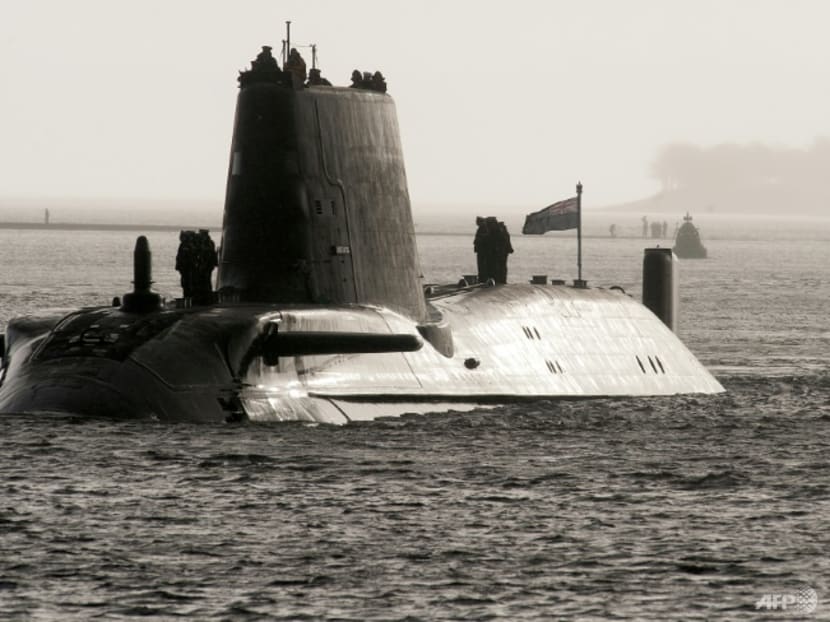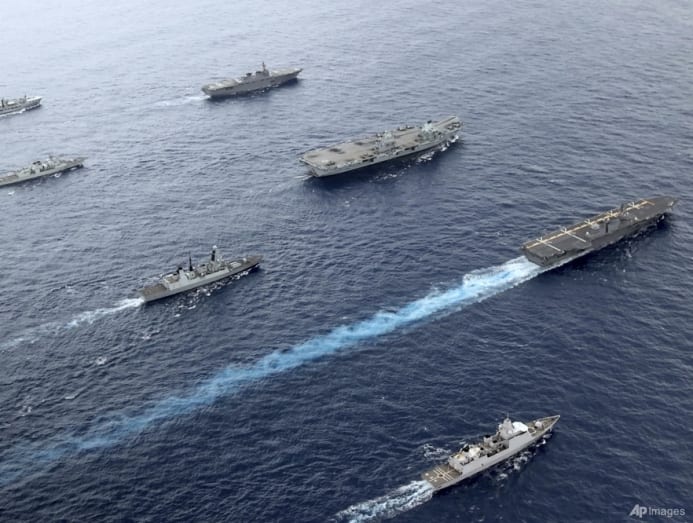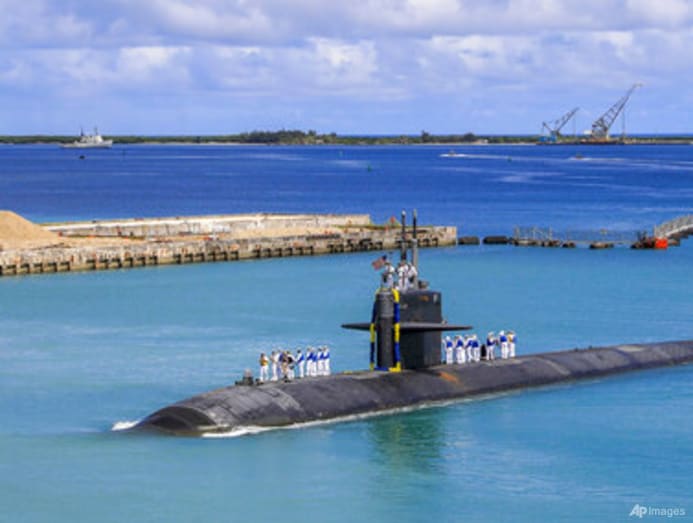Commentary: What difference would nuclear submarines really make to Australia?
The biggest impact they have is in the demonstrated commitment and future collaboration among the AUKUS powers to tackle a new strategic environment, says James Goldrick.

Only six countries in the world, including Britain, have nuclear-powered submarines. (Photo: AFP)
CANBERRA: The most important point about Australia’s decision to scrap its diesel-electric submarine deal with France in favour of acquiring boats of United States or British design is that these will be nuclear-powered, but not nuclear-armed.
Neither the new submarines nor any other Australian unit will carry nuclear weapons.
Australia approaches nuclear matters with caution. The country is a signatory to the 1973 nuclear Non-Proliferation Treaty and the 1998 Comprehensive Test Ban Treaty, and has no intention of breaching its commitments.
It is also party to the Treaty of Rarotonga establishing a nuclear weapon-free zone in the South Pacific which prohibits the testing, manufacturing, acquiring and stationing of nuclear explosive devices on any member’s territory and the dumping of radioactive waste into the sea.
The desire to limit Australia’s nuclear commitments in this case is a key argument for buying American or British designed nuclear-powered submarines.
BOLSTERING AUSTRALIA’S SUBMARINE CAPABILITIES
Nuclear-powered boats are speedier and have greater endurance. Diesel-electric submarines have to charge their batteries at intervals, risking detection by an adversary and reducing their own ability to detect others.
They can only sprint for a few minutes at speeds nuclear-powered submarines can maintain indefinitely.
The first time the US is sharing nuclear-powered submarine technology with an ally since the 1958 US-UK Mutual Defence Agreement after the formation of NATO, the AUKUS arrangement sends a strategic signal of Australia’s enhanced geostrategic role in Indo Pacific security.
And why not when Australia’s current submarines represent a significant potential contribution to any alliance underwater campaign and Australia’s own defences?
Although Australia's current six Collins-class submarines long had bad press, these boats have achieved high levels of operational involvement in exercises and operations in recent years. The numbers of qualified submariners have also increased, an important condition for any future expansion.
Their ability to deploy around the region had public confirmation in early 2020 when HMAS Dechaineux became the first foreign submarine to berth in Malaysia’s submarine base at Kota Kinabalu. Other deployments range even further afield.
Progressive modernisation of sensors and systems has already started, but even now, the Collins-class are among the most capable diesel-electric boats in the world.
They are extremely stealthy when running on battery power. They are armed with the latest variant of the US Mark 48 torpedo as well as the subharpoon anti-ship missile.
The cancelled French design would have been similarly fitted with American systems and weapons. Australia will want its nuclear submarines to share US technology in the same way.
But the much greater carrying capacity of large nuclear submarines such as the US Navy’s Virginia-class, their great speed and long endurance will make them a formidable addition to Australia’s ability to project power well away from Australian territory.
The new submarines also bring gains in military-to-military ties. Though the relationship between Australia’s submarine service and the United States Navy in the Pacific is already close, cooperation with Japan, another regional maritime power with 22 very capable conventional submarines, is likely to develop in the years ahead.

DOUBTS OVER FRENCH SUBMARINE PROGRAMME
Australia’s decision to abandon the construction of French designed diesel-electric submarines came as a surprise to many, but there were red lights blinking over several aspects of the project.
There were increasing concerns over cost increases, delays and fears of insufficient Australian industry participation expressed bilaterally and publicly since the deal was inked in 2016.
Even more significant were growing fears that conventional boats could not meet Australia’s needs in an increasingly complex strategic environment.
Much has changed since 2016, when Australia embarked on the now cancelled programme with France, overriding a national aversion to nuclear power, the absence of an Australian nuclear industry, and the sheer expense of nuclear submarines.
The need to balance China’s naval expansion, to provide a substantial, credible contribution to alliance effort at sea and to have an Australian national capability to make any would-be aggressor think twice have combined with disillusionment over the conventional submarine project to make nuclear power much more attractive.
At a time of strategic uncertainty, the increase in Australia’s naval capabilities which the change to nuclear power offered is too great to forego.
CHANGES WILL COME SLOWLY
Changes to the Australian submarine force will not happen overnight. The Collins-class will continue to be at the leading edge of Australia’s maritime defences well into the next decade.
The Australian government had announced a Life of Type Extension programme beginning in 2026 when the first boat enters full cycle docking. The remainder will follow at two-year intervals.
Australia plans to spend 18 months working out the way ahead with both the Americans and the British. Much will depend on how much they can support the Australian endeavour and the priority which Australia gives to acquiring additional capability.
An in-country build programme, which remains Australia’s long-term intention, cannot start to produce completed boats before the end of the 2030s.
Help with training will be essential, so will other forms of naval assistance. Any hope of acquiring nuclear powered units in the next decade depends on whether the US or UK can spare second-hand boats and what spare capacity, if any, exists in their building yards.
At best, a training boat on lease is unlikely to be in Australian service in much less than five years from now and new construction units cannot be expected to enter operational service before about 2030.
This is assuming the Americans can make room on their current two-boat-a-year production line, a more likely prospect than the smaller British effort.

Support facilities must be built in Australia for nuclear-powered boats for routine maintenance, major full-cycle dockings and refits. These will need to meet international nuclear safety standards.
Navy personnel must be selected and trained in sufficient numbers and to the degree necessary to meet the exacting standards of nuclear power. Australia’s navy will take the lead here from US Navy and British Royal Navy standards and practices.
There will be no short cut to this as Australia has few nuclear technicians. But the gears are already shifting as the University of New South Wales announced last week an expansion of its nuclear engineering programme and scholarships for 20 students.
Australia’s new nuclear submarine project represents a capability for the longer-term future, rather than the next few years.
The decision to adopt nuclear power is also significant for what it says about the readiness of all three partners of AUKUS to develop closer links to support collective security in an uncertain strategic environment.
But these boats will only be one part of a matrix of increasing technology, intelligence and operational cooperation – a matrix which, despite the concerns expressed in Europe, will come to involve many other partners in many ways.
James Goldrick is an Adjunct Professor at the Strategic and Defence Studies Centre of the Australian National University and at the University of New South Wales Canberra. He retired from the Royal Australian Navy as a two-star Rear Admiral in 2012.









